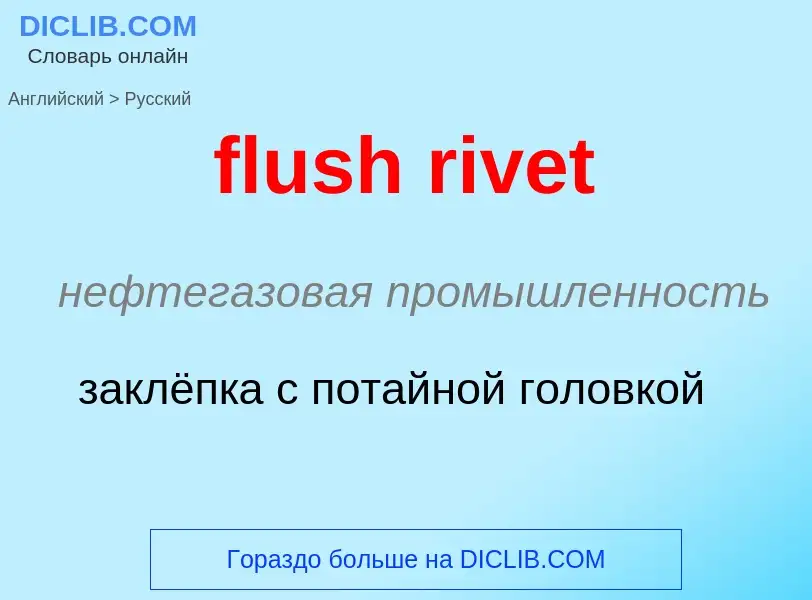Tradução e análise de palavras por inteligência artificial ChatGPT
Nesta página você pode obter uma análise detalhada de uma palavra ou frase, produzida usando a melhor tecnologia de inteligência artificial até o momento:
- como a palavra é usada
- frequência de uso
- é usado com mais frequência na fala oral ou escrita
- opções de tradução de palavras
- exemplos de uso (várias frases com tradução)
- etimologia
flush rivet - tradução para russo
нефтегазовая промышленность
заклёпка с потайной головкой
общая лексика
заклепанный
заклепочный
Wikipédia

A rivet is a permanent mechanical fastener. Before being installed, a rivet consists of a smooth cylindrical shaft with a head on one end. The end opposite the head is called the tail. On installation, the rivet is placed in a punched or drilled hole, and the tail is upset or bucked (i.e., deformed), so that it expands to about 1.5 times the original shaft diameter, holding the rivet in place. In other words, the pounding or pulling creates a new "head" on the tail end by smashing the "tail" material flatter, resulting in a rivet that is roughly a dumbbell shape. To distinguish between the two ends of the rivet, the original head is called the factory head and the deformed end is called the shop head or buck-tail.
Because there is effectively a head on each end of an installed rivet, it can support tension loads. However, it is much more capable of supporting shear loads (loads perpendicular to the axis of the shaft).
Fastenings used in traditional wooden boat building, such as copper nails and clinch bolts, work on the same principle as the rivet but were in use long before the term rivet was introduced and, where they are remembered, are usually classified among nails and bolts respectively.




![An original structural steel rivet from the [[Golden Gate Bridge]] (1937). Removed and replaced c. 2000 during work to reinforce the structure to resist seismic loads. An original structural steel rivet from the [[Golden Gate Bridge]] (1937). Removed and replaced c. 2000 during work to reinforce the structure to resist seismic loads.](https://commons.wikimedia.org/wiki/Special:FilePath/Golden Gate Bridge Rivet 1937.jpg?width=200)
![M3 tank]] hull M3 tank]] hull](https://commons.wikimedia.org/wiki/Special:FilePath/M3 tank riveting LOC fsa 8e10699.jpg?width=200)




![Riveting team working on the cockpit shell of a [[C-47]] transport at the plant of [[North American Aviation]]. The woman on the left operates an air hammer, while the man on the right holds a bucking bar. Riveting team working on the cockpit shell of a [[C-47]] transport at the plant of [[North American Aviation]]. The woman on the left operates an air hammer, while the man on the right holds a bucking bar.](https://commons.wikimedia.org/wiki/Special:FilePath/Riveting team2.jpg?width=200)
![A riveted [[truss bridge]] over the [[Orange River]] A riveted [[truss bridge]] over the [[Orange River]]](https://commons.wikimedia.org/wiki/Special:FilePath/Rivets on General Hertzog Bridge.jpg?width=200)
![Spitfire]] aircraft Spitfire]] aircraft](https://commons.wikimedia.org/wiki/Special:FilePath/Speed in the Workshops - Speed in the Air - Geo Tucker Eyelet Co 01.jpg?width=200)
